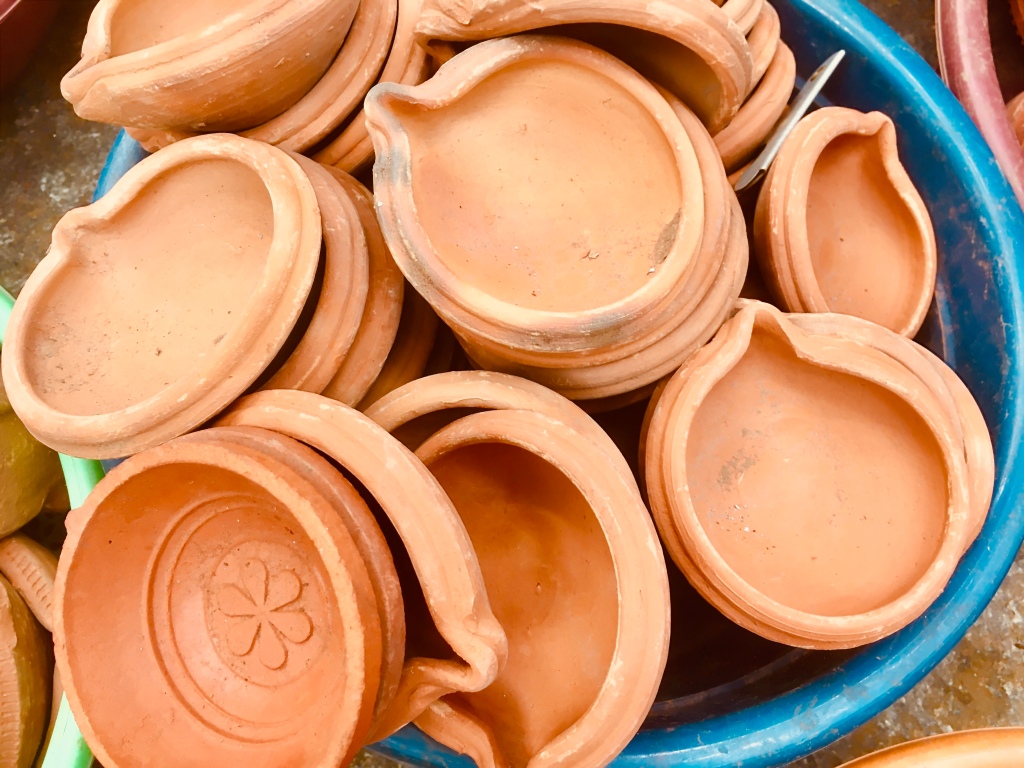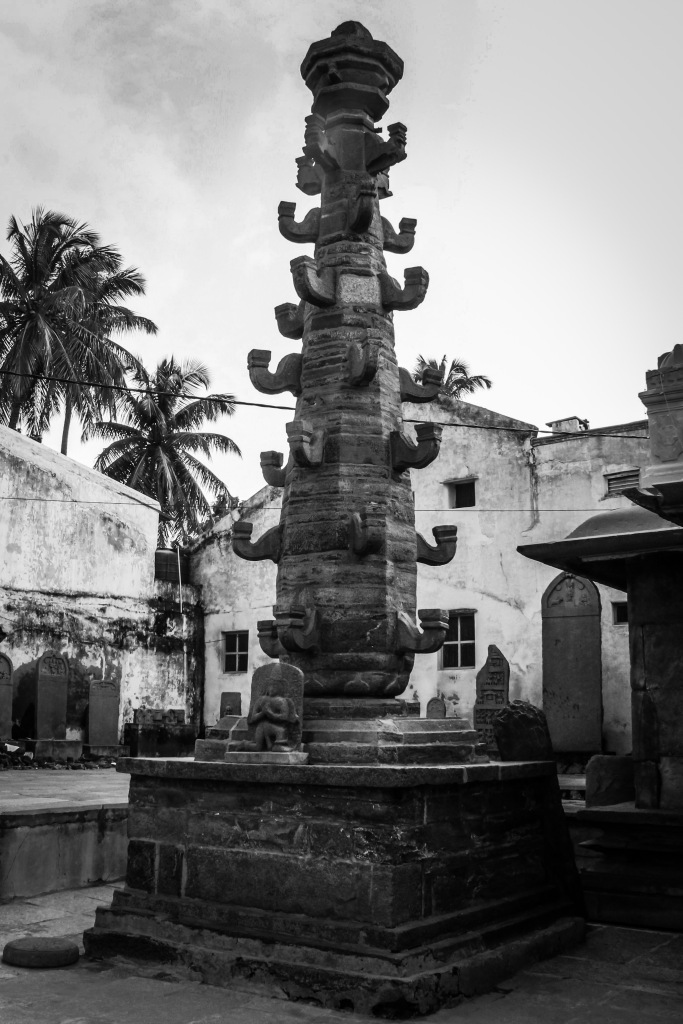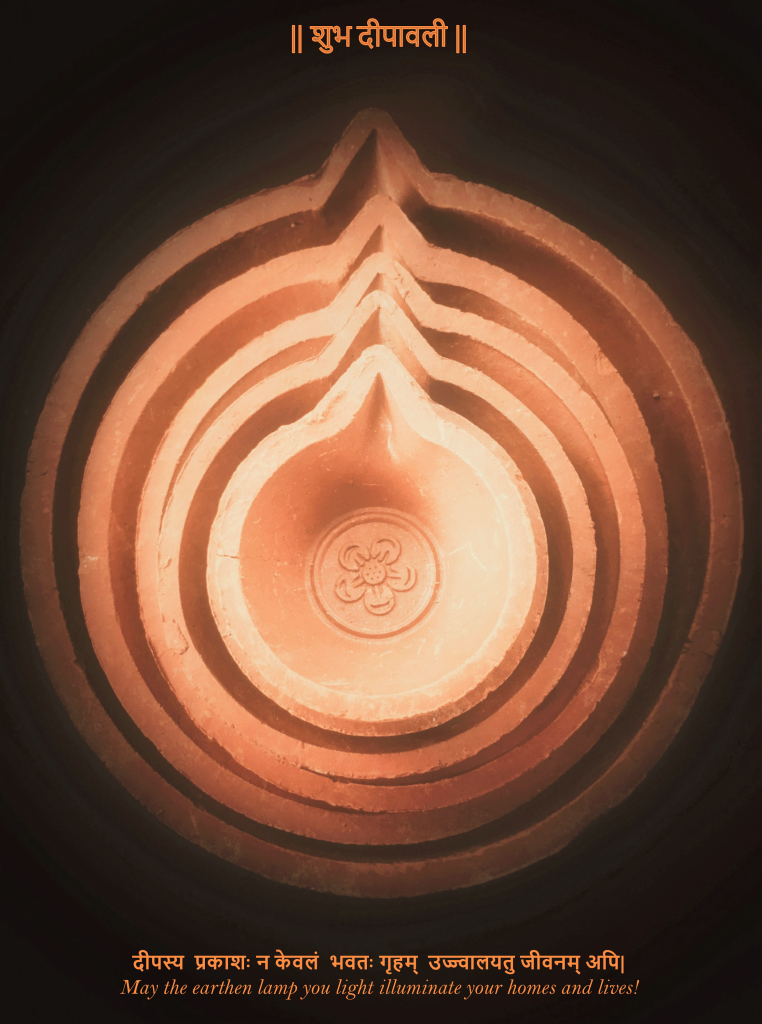Deepavali is the festival of lights.
Literally, a row of lights (Deepa – lamp light, avali – row) lit to dispel darkness, celebrated on a new-moon night, in the Indian calendar month of Kartik.
Many mythological stories and legends abound on the events that led to celebrating the festival of lights, with a regional flavour – as also the origins and types of fire-crackers used, but all that’s for another day.

Lamps made of clay have a native charm. The handmade red-ochre deepa are traditionally made by potters, painstakingly following age-old pottery techniques. Earthen Pottery in India can be traced back, historically, earlier to 2,000 BCE, or beginning of the Harappan civilisation.
Scouring Bangalore’s markets for handmade earthen lamps/deepa was a learning experience. Though we had always sought earthen lamps, ‘handmade‘ was of special focus this Deepavali – for various reasons – a) they are easier to make, b) consume lesser clay per piece, c) easily return to earth, d) of course, cost less.
The potter’s clay is a mixture of soft soil taken from river basins and village tanks, fertile soil from irrigation water-structures, and sand from river beds. The mixture is wetted with water, left for a week to sag and then stomped continuously for a couple of hours for a smooth texture. The softened clay is then hand-crafted into little deepas. Once the wares are made, they are left to dry in the sun for two days (coloured with red-ochre in some areas) and then baked in an earthen oven / kilns at 120 degrees for 12 hours. Stacks of hay, field-straw, twigs and even dead branches of native trees are used as fuel. Naturally, earthenware flourished in the regions where large perennial-rivers flowed. Though few rivers died (like the Saraswati), the craft sustained or adapted to new situations.
Across India, regional techniques of clay pottery evolved over centuries, and continues to this day – most notable are: Kangra in Himachal, Mansa, Bankura, and Midnapore in West Bengal, Alwar and Molela in Rajasthan, Nizamabad and Prayagraj in UP, Kutch and Saurashtra in Gujarat, Delhi-Haryana region, Thane and western Maharashtra; in the South, the loamy soil of Manamadurai and 15 surrounding villages in Tamil Nadu dominate the deepa market, while Kerala’s Peringottukurissi near Ernakulam, Peruvemba and Ezhumangad near Palakkad, Doora in Mysore dist, Khanapur near Belgaum, Chitoor dist of Andhra, and n small pockets of Konkan, Goa and Pondicherry are the others.
Many of the potters, Kumbhars (kumbh – pot), have carried their regional traditions over generations. Of them, very few continue to make deepas by hand – most have switched to moulds. Down a slippery slope, the art is on the wane – lack of skill lead in the current generation led to poor quality and resultant breakage (both handling and transport). Evidently, moulded lamps are more sought after by makers and sellers. Historically, there have been many forms / types of lamps used in festivities, including stone, brass, bell-metal, silver, even gold. Temples especially preferred deepa stambha (pillar of lamps) made of stone (granite of choice).

at Sri Harihareshwara Temple, Harihar – built in 1224 AD by a Hoysala general Polalva
A potter uses ~75 kgs of clay for a thousand handmade deepa of 2” dia in a day; while moulded ones require almost double the quantity but lesser time. Cost-wise, handmade ones sell Rs. 30 per doz in the cities, for simple elegant types without flashy paints, kitsch; while mould ones cost double. Traditional deepa are preferred, but lesser in demand and the cheap imported plastic items have taken over the scene.
Led fairy lights, plastic/paper lanterns, or wax candles, pale in comparison to the warm-glow of the earthen lamps – they are not only friendly to the earth but also provide livelihood to the thousands of kumbhars, who live in poverty and infinite-debt.
The lady from whom I ultimately bought the handmade lamps revealed that 90% of earthen lamps sold in Bangalore come from TN. Our own Pottery town is in shambles, as many potters shifted out over the years, and those who have remained are content making commercially viable articles like planters, water-pots, even kulhads / tea-cups. Deep search yields moulded earthen lamps upon coaxing, that too in joint-family-homes where older generations still exist.
Lighting lamps are a means to not only get rid of darkness, but also denotes dispelling anger, greed, hatred and all such unwelcome feelings. The lamps also stand for good luck. The traditional deepa were lit using cow-ghee or til/sesame seed oil or coconut oil in coastal areas with wicks made of cotton; but recently, various oils and blends are used in the name of ‘deepam-oil’.
A lamp lit with ghee emits satvik vibrations and thus completes the wholesome spiritual experience. an oil lamp too emits positive vibrations, but at a lesser frequency. It is also said, the fumes and heat generated from a ghee-lamp are beneficial in health perspective; which isn’t the case with oils, especially the recent blends, which contain mineral oil (refined waste machine-oil derived from petrol), Paraffin, and Palm oil.
Did you know?
Earthen lamps, called Deepa in Sanskrit and its derived dialects across India, diya in Hindi-Arabic, vilakku in Tamil-Kerala, pramida in Telugu, matira-pradipa in Bengali, among others.
Terracotta originated from terra cocta, meaning earth-baked in Italian, and includes both glazed and non-glazed pottery. It has come to be used as a common term for all earthen items across the world.
A Sanskrit shloka encapsulates the essence of lighting a lamp:
शुभं करोति कल्याणमारोग्यं धनसंपदा ।
शत्रुबुद्धिविनाशाय दीपज्योतिर्नमोऽस्तुते ॥
That which bestows auspiciousness, health, wealth and prosperity,
which destroys inimical feelings and hatred,
Salutations to the light of the lamp!
This year, Deepavali is special; the world is going through a tricky but deadly pandemic, which is seen waning one day, but resurfacing with a vengeance the next! India is the second most affected nation and there isn’t a cure worth of mention. Precautions to avoid Covid-19 ought to continue, and festivities should be muted, celebrated in spirit.
So, keep it earthy, simple, and stay safe!
Shubh Deepavali!
शुभ दीपावली!

Images in this post belong to the author. Information gleaned from various sources, incl kumbhars,sellers and the net.


